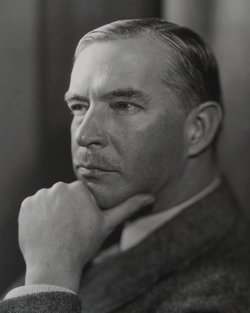
John Phillips Marquand was an American writer. Originally best known for his Mr. Moto spy stories, he achieved popular success and critical respect for his satirical novels, winning a Pulitzer Prize for The Late George Apley in 1938. One of his abiding themes was the confining nature of life in America's upper class and among those who aspired to join it. Marquand treated those whose lives were bound by these unwritten codes with a characteristic mix of respect and satire.

Mr. Moto is a fictional Japanese secret agent created by the American author John P. Marquand. He appeared in six novels by Marquand published between 1935 and 1957. Marquand initially created the character for the Saturday Evening Post, which was seeking stories with an Asian hero after the death of Charlie Chan's creator Earl Derr Biggers.

Robert Stack was an American actor. Known for his deep voice and commanding presence, he appeared in over forty feature films. He starred in the ABC television series The Untouchables (1959–1963), for which he won the 1960 Primetime Emmy Award for Outstanding Performance by an Actor in a Series, and later hosted/narrated the true-crime series Unsolved Mysteries (1987–2002). He was also nominated for an Academy Award for Best Supporting Actor for his role in the film Written on the Wind (1956).
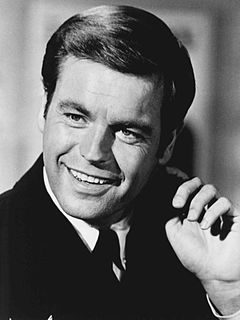
Robert John Wagner Jr. is an American actor of stage, screen, and television. He is known for starring in the television shows It Takes a Thief (1968–1970), Switch (1975–1978), and Hart to Hart (1979–1984). He later had a recurring role as Teddy Leopold in the TV sitcom Two and a Half Men (2007–2008) and made twelve guest appearances (2010–2019) as Anthony DiNozzo Sr. in the police procedural NCIS.

Eamon Joseph O'Brien was an American actor and film director. His career spanned almost 40 years, and he won one Academy Award, two Golden Globe Awards, and two stars on the Hollywood Walk of Fame.
Joseph M. Newman was an American film director most famous for his 1955 film This Island Earth. His credits include episodes of The Twilight Zone and The Alfred Hitchcock Hour.

Rory Calhoun was an American film and television actor, screenwriter and producer. He starred in numerous Westerns in the 1950s and 1960s, and appeared in supporting roles in films such as How to Marry a Millionaire (1953).
Harry Black is a 1958 British film adaptation of the novel Harry Black by David Walker, released by 20th Century Fox.
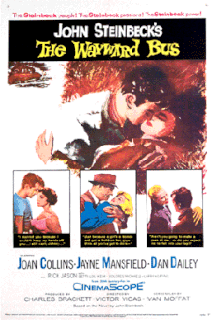
The Wayward Bus is a 1957 American drama film directed by Victor Vicas and starring Joan Collins, Jayne Mansfield, Dan Dailey and Rick Jason. Released by 20th Century Fox, the film was based on the 1947 novel of the same name by John Steinbeck.

The Sun Also Rises is a 1957 American drama film adaptation of the 1926 Ernest Hemingway novel of the same name directed by Henry King. The screenplay was written by Peter Viertel and it starred Tyrone Power, Ava Gardner, Mel Ferrer, and Errol Flynn. Much of it was filmed on location in France and Spain as well as Mexico in Cinemascope and color by Deluxe. A highlight of the film is the famous "running of the bulls" in Pamplona, Spain and two bullfights.
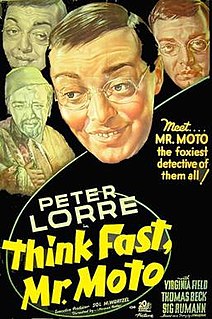
Think Fast, Mr. Moto is a 1937 film directed by Norman Foster and featuring a mysterious Japanese detective named Mr. Moto. It is the first of eight films in the Mr. Moto series, all based on the character Mr. Moto created by John P. Marquand. The film stars Peter Lorre as the title character, Virginia Field, Thomas Beck and Sig Ruman. Mr. Moto works to stop a secret smuggling operation.

Thank You, Mr. Moto is a 1937 film directed by Norman Foster. It is the second in a series of eight films starring Peter Lorre as Mr. Moto. It was based on the novel of the same name by the detective's creator, John P. Marquand. Mr. Moto battles murderous treasure hunters for priceless ancient scrolls which reveal the location of the long-lost tomb of Genghis Khan.
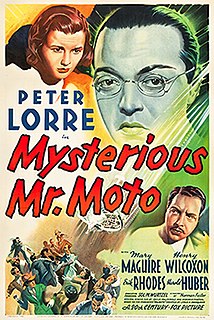
Mysterious Mr. Moto, produced in 1938 by Twentieth Century Fox, is the fifth in a series of eight films starring Peter Lorre as Mr. Moto.

Thank You, Mr. Moto, was originally published in serial form in the Saturday Evening Post from February 8 to March 14, 1936, this novel was first published in book form in 15 May 1936.
Mr. Moto's Last Warning is the sixth in a series of eight films starring Peter Lorre as Mr. Moto.

Lancer Spy is a 1937 American thriller film about an Englishman (Sanders) who impersonates a German officer, receiving fame upon arriving in Germany. A female German spy is instructed to check on him but falls in love with him instead.
Mr. Moto Is So Sorry was originally published in serial form in the Saturday Evening Post from July 2 to August 13, 1938, and was first published in book form in 1938. It is the fourth of six Mr. Moto novels and can also be found in the omnibus Mr. Moto's Three Aces published in 1939.

Mr. Moto Takes a Chance is the fourth in a series of eight films starring Peter Lorre as Mr. Moto, although it was the second one actually filmed, following Think Fast, Mr. Moto. Its release was delayed until after production of Thank You, Mr. Moto and Mr Moto's Gamble.

Mr. Moto in Danger Island is a 1939 American mystery film directed by Herbert I. Leeds and starring Peter Lorre, Jean Hersholt and Amanda Duff. It is part of the Mr. Moto series of films.















